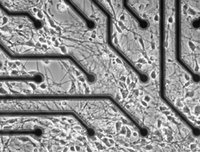Neurorobotics
 Several researchers at Northwestern have created a hybrid neurorobotic system, consisting of a brain-machine interface between a Khepera base module and lamprey brainstem. These two components are connected in a closed-loop, so that the resulting "neurobot" is entirely autonomous and displays behavior eerily reminscent of the animal from which its brain was removed.
Several researchers at Northwestern have created a hybrid neurorobotic system, consisting of a brain-machine interface between a Khepera base module and lamprey brainstem. These two components are connected in a closed-loop, so that the resulting "neurobot" is entirely autonomous and displays behavior eerily reminscent of the animal from which its brain was removed.Lampreys are jawless, eel-like fish whose locomotor systems have been extensively studied. The researchers explanted a region of the lamprey brainstem that is known to stabilize swimming and keep the lamprey upright by receiving vestibular input. In the robot, two electrodes instead applied stimulation to the reticular formation (specifically to intermediate and posterior octavomotor nuclei), where the stimulation rates were proportional to the light intensity as measured on each side of the robot. Two electrodes placed on a part of the reticular formation (the right and left posterior rhombencephalic reticular nuclei) - the region that normally sends swimming motor commands - received input from the explanted brain, and caused the robot's two wheels to turn proportional to the spike rates measured by the electrodes.
These modifications caused the neurobot to become phototactic and move towards light - just as this area tracks and maintains the vertical axis in swimming and intact lampreys. It is an elegant demonstration of the abstract, content-invariant information processing performed by neural networks. Current work by these researchers is exploring the use of combinations of electrical stimuli and pharmacological agents, such as those founds in vivo, to manipulate plasticity and other neural functions.
Researchers at the biologically-inspired robotics group of Ecole Polytechnique Fédérale de Lausanne (the same university to work with IBM on Blue Brain) have taken this work a step farther - by adding anatomically correct biomechanics. In addition to similar work with lampreys, they have also used neural networks and genetic algorithms in tandem to reproduce the neuromechanics of salamanders, one of the first veterbrates thought to have made the transition from aquatic to terrestrial life. There are several animations and diagrams of the resulting network structure available here. Using some of the same networks seen in lampreys, they claim to faithfully reproduce not only salamander locomation, but also the evolution of this terrestrial locomotion from more basic swimming behavior.
In many ways, neurorobotics is a natural complement to computational modeling. Some have stressed the importance of physically instantiating neural network models as a way to verify their plausibility: the integration of neurophysiology can bridge the philosophical divide between abstract simulation and empirical research. Others might argue for the long-term advantages of neurobotics: binding and embodiment are likely properties that emerge only in the interaction of an agent with its physical environment. Even areas of the brain responsible for language (e.g., Broca's area) are located within motor cortex, suggesting a rather deep connection between our physical interactions with the environment and the way that higher cognitive functions are structured and sequenced.
Related Posts:
Emotional Robotics
A Mind of Its Own: Wakamaru
Imitation vs Self-Awareness: The Mirror Test
Mind Games: Humans, Dolphins and Computers


1 Comments:
Interesting stuff. Maybe you can update the Wikipedia article and share your expertise with a wider audience?
http://en.wikipedia.org/wiki/Neurorobotics
,D
Post a Comment
<< Home